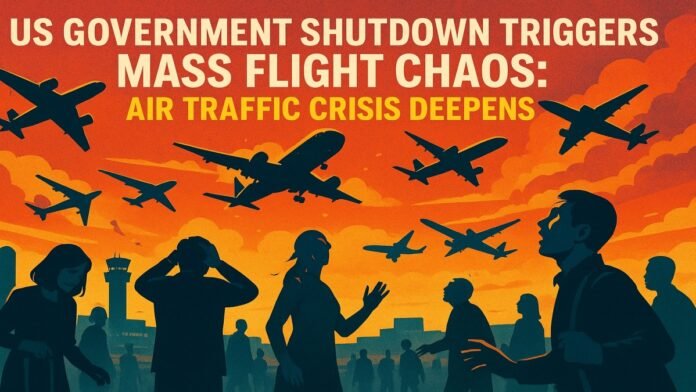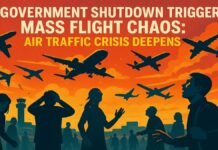
Key Points
- Over 13,000 air traffic controllers and 50,000 TSA officers working without pay since October 1, 2025
- Federal Aviation Administration mandated gradual flight reductions: 4% starting November 7, escalating to 10% by November 14
- Sunday, November 9, marked the worst day with 2,800+ cancellations and over 10,000 delays nationwide
- Between 20-40% of air traffic controllers absent from work at the nation’s 30 largest airports
- Transportation Secretary warns air travel could “dwindle to a trickle” before Thanksgiving if shutdown continues
- Over 3.2 million travelers impacted by delays or cancellations since shutdown began
- Republicans hold 53 Senate votes but need 60 to overcome Democratic filibuster on temporary funding bill
Washington D.C.: The unprecedented government shutdown has triggered the worst aviation crisis in modern American history, with weekend travel descending into chaos as mandatory flight reductions took effect. According to FlightAware’s flight tracking service, Sunday, November 9, 2025, marked the most disruptive day since the shutdown began on October 1, with over 2,800 flights canceled and more than 10,000 delays reported nationwide.
The escalation in cancellations has been dramatic and swift. While 202 flights were canceled on Thursday, November 6, the number surged to 1,025 on Friday, November 7, and climbed to 1,566 on Saturday, November 8. By Sunday at 10:30 AM Eastern time, 1,375 flights had already been canceled. The Federal Aviation Administration reported that staffing shortages affected 42 airport control towers and facilities, causing delays in at least 12 major cities, including Atlanta, Newark, San Francisco, Chicago, and New York.
Major airports experienced devastating disruption rates. Hartsfield-Jackson Atlanta International Airport, which typically serves around 286,000 passengers daily, experienced a 19% cancellation rate of its flights on Saturday. At New York’s John F. Kennedy International Airport, 45% of flights faced delays the same day. Charlotte Douglas International Airport experienced a staggering 72% delay rate on Saturday morning, with 94 out of 131 flights delayed.
Regional carrier SkyWest faced particularly severe challenges with approximately 8% of its entire fleet grounded. Major carriers Delta and Southwest Airlines each reported more than 100 cancellations. FlightAware data indicates that airports in Atlanta, New York, Charlotte, Chicago, and Orlando are experiencing the highest volumes of cancellations and delays.
Air Traffic Controller Crisis Deepens
The shutdown, now in its 36th to 39th day depending on the reporting date, has forced approximately 13,000 air traffic controllers and 50,000 Transportation Security Administration officers to continue working without compensation. This unprecedented situation has created severe staffing shortages as controllers increasingly fail to report for duty after missing paychecks for several weeks.
FAA Administrator Bryan Bedford reported on November 5 that between 20% and 40% of controllers at the agency’s 30 largest airports were absent from work. The staffing crisis has triggered broad secondary impacts, including late aircraft arrivals, crew legality issues, and equipment mispositioning throughout the national aviation system.
In response to the escalating crisis, Transportation Secretary Sean Duffy announced on November 5 that he would mandate a 10% decrease in scheduled air traffic at 40 key airports starting Friday, November 7, unless an agreement is reached to resolve the shutdown. The reductions began at 4% on Friday and are scheduled to increase to 6% on Tuesday, November 11, before escalating to the full 10% by November 14. These cuts are enforced between 6 AM and 10 PM local time and affect all commercial airlines.
Duffy told reporters, “We had to take a step back,” explaining his rationale for the flight reductions. He warned that further cuts, potentially reaching 20% might become necessary if controllers miss a second consecutive paycheck and more workers fail to report for duty.
Economic Impact and Thanksgiving Travel Concerns
Transportation Secretary Sean Duffy issued stark warnings about the economic consequences during a CNN interview on Sunday, November 9. “Looking ahead to two weeks from now, as we approach Thanksgiving travel, air travel is likely to slow significantly as everyone tries to visit their families,” Duffy explained. He cautioned that air traffic across the United States could “dwindle to a trickle” if the shutdown extends into the peak Thanksgiving travel period.
The Director of the National Economic Council echoed these concerns, stating that if Americans are unable to travel during Thanksgiving, one of the nation’s most important holidays, the country’s economy could suffer negative impacts in the fourth quarter of 2025. An industry group has estimated that over 3.2 million travelers have already been impacted by flight delays or cancellations due to increasing air traffic controller absences since October 1.
The economic ripple effects extend far beyond airline passengers. Mike Raaff, CEO of Private Aviation, emphasized the widespread consequences: “This is going to impact everything from cargo aircraft getting delivered to people being able to get to meetings to being able to travel. It’s going to affect hotel taxes and city taxes. There’s a cascading effect that results from this situation”. The reductions in air traffic are anticipated to significantly impact deliveries and shipping since commercial aircraft often serve as freight carriers.
Car rental company Hertz reported a 20% increase in one-way car bookings compared to the same weekend last year, indicating that travelers are seeking alternative transportation methods to avoid the aviation chaos. Airlines have consistently called for an end to the shutdown, citing serious concerns over aviation safety. Shares of major carriers, including United Airlines and American Airlines, declined approximately 1% in after-hours trading following the announcement of mandatory flight reductions.
Political Stalemate Over Funding
The federal government remains largely shut down as Republicans and Democrats remain at an impasse in Congress over a funding bill. The current political standoff centers on a temporary spending solution that is stalled in the Senate due to the legislative procedure known as the “filibuster”.
Under Senate rules, the filibuster requires 60 votes to overcome, rather than a simple majority. The Republican Party currently holds 53 Senate seats, falling short of the 60-vote threshold needed to advance the temporary funding proposal. This procedural obstacle allows senators to delay or prevent a vote on proposed bills or funding measures by prolonging debate indefinitely.
Democrats have insisted on including health insurance subsidies, which are set to expire at the end of 2025, in any funding agreement. Republicans have rejected that proposal, creating a deadlock that has persisted for over a month. Democrats attribute the shutdown to Republicans’ refusal to negotiate over these expiring subsidies.
Former President Trump has called for eliminating the filibuster so that Republicans could pass funding and budget proposals with a simple majority vote. However, such a change would require Senate approval and represents a fundamental alteration to the chamber’s longstanding rules and traditions.
Aviation Safety Concerns Mount
On November 5, Transportation Secretary Duffy warned that if the shutdown extends into the following week, it could result in “mass chaos” and potentially force him to close parts of the national airspace to air traffic a measure that could disrupt American aviation on an unprecedented scale. The FAA has indicated that it may implement additional flight restrictions beyond Friday if air traffic problems persist.
Airlines, while stating that the shutdown has not drastically affected their overall business operations, have warned that bookings may decline significantly if the situation continues. The industry has been voicing urgent concerns to lawmakers regarding operational impacts and safety considerations.
As the United States approaches its peak travel season with Thanksgiving at the end of November, followed by another wave of travel during Christmas and New Year’s, lawmakers could face substantial backlash from constituents if delays and cancellations persist. The turmoil at US airports has intensified pressure on both Democrats and Republicans to resolve the shutdown, though a consensus on government spending remains frustratingly elusive.
The situation represents an unprecedented test of the nation’s aviation infrastructure and political system, with millions of Americans facing uncertain travel prospects during the holiday season and the broader economy threatened by cascading disruptions across multiple sectors.


















































